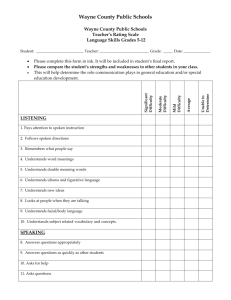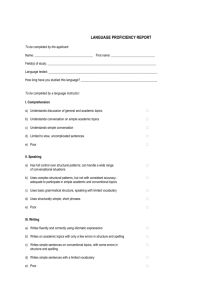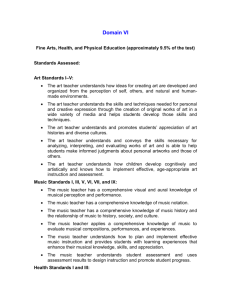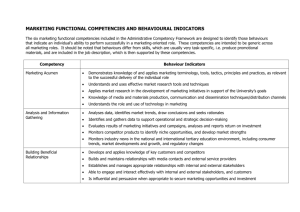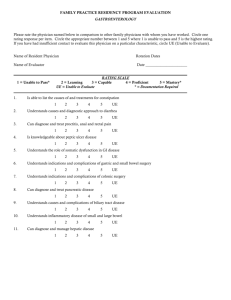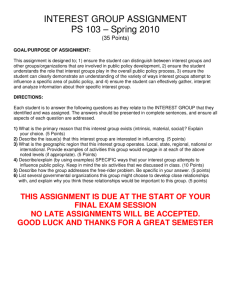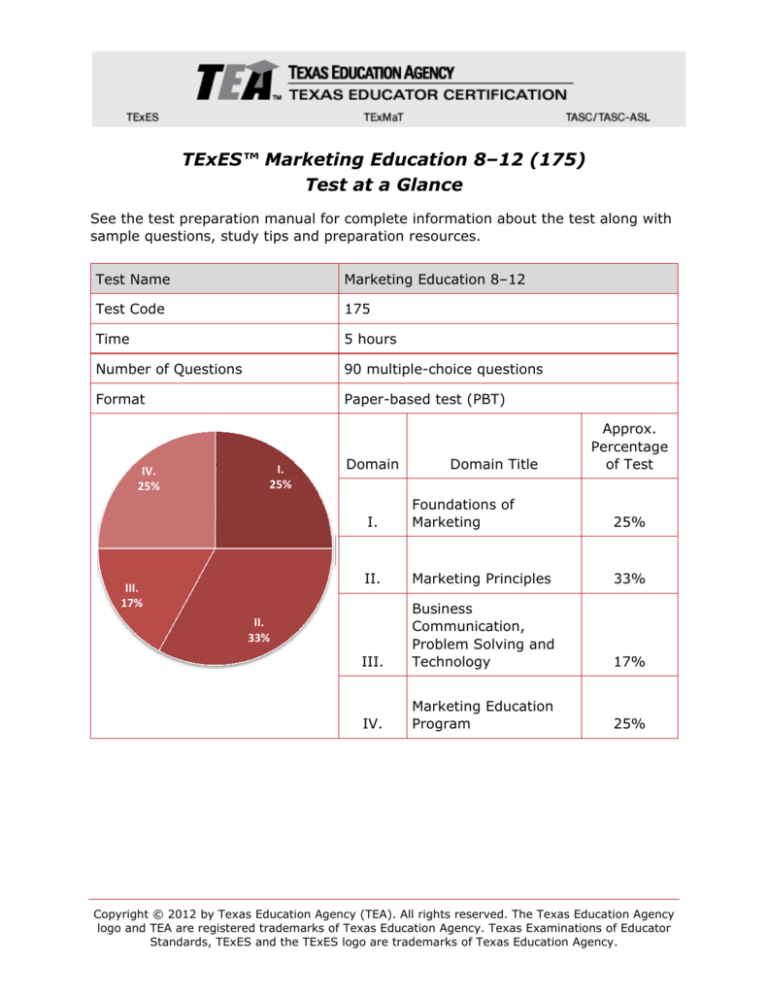
TExES™ Marketing Education 8–12 (175)
Test at a Glance
See the test preparation manual for complete information about the test along with
sample questions, study tips and preparation resources.
Test Name
Marketing Education 8–12
Test Code
175
Time
5 hours
Number of Questions
90 multiple-choice questions
Format
Paper-based test (PBT)
V.
0%
IV.
25%
VI.
0%
I.
25%
III.
17%
Domain
Domain Title
Approx.
Percentage
of Test
I.
Foundations of
Marketing
25%
II.
Marketing Principles
33%
III.
Business
Communication,
Problem Solving and
Technology
17%
IV.
Marketing Education
Program
25%
II.
33%
Copyright © 2012 by Texas Education Agency (TEA). All rights reserved. The Texas Education Agency
logo and TEA are registered trademarks of Texas Education Agency. Texas Examinations of Educator
Standards, TExES and the TExES logo are trademarks of Texas Education Agency.
About This Test
The TExES Marketing Education 8–12 (175) test is designed to assess whether an
examinee has the requisite knowledge and skills that an entry-level educator in
this field in Texas public schools must possess. The 90 multiple-choice questions
are based on the Marketing Education 8–12 test framework. Questions on this test
range from grades 8–12. The test may contain questions that do not count toward
the score.
The Test Framework
The Marketing Education 8–12 test framework is based on the educator standards
for this field. The content covered by the test is organized into broad areas
of content called domains. Each domain covers one or more of the educator
standards for this field. Within each domain, the content is further defined by
a set of competencies. Each competency is composed of two major parts:
The competency statement, which broadly defines what an entry-level
educator in this field in Texas public schools should know and be able to do.
The descriptive statements, which describe in greater detail the knowledge
and skills eligible for testing.
The educator standards being assessed within each domain are listed on the next
page. These are followed by a complete set of the framework’s competencies and
descriptive statements. Read each competency with its descriptive statements to
get a more specific idea of the knowledge you will be required to demonstrate
on the test.
TExES Marketing Education 8–12 (175)
Page 2 of 14
Educator Standards
Marketing Education 8–12 Standard I
The marketing education teacher understands and applies knowledge of the
foundations of marketing, including principles and techniques related to business,
economics, management and entrepreneurship.
Marketing Education 8–12 Standard II
The marketing education teacher understands and applies knowledge of marketing
principles, concepts and techniques.
Marketing Education 8–12 Standard III
The marketing education teacher understands and applies principles, concepts and
techniques related to international business and marketing.
Marketing Education 8–12 Standard IV
The marketing education teacher understands and applies knowledge of
technological, quantitative, communication and career-development skills
for the marketing sector.
Marketing Education 8–12 Standard V
The marketing education teacher knows how to advise and assist students in career
planning and promote student development through work-based learning and
participation in student organizations such as DECA.
Marketing Education 8–12 Standard VI
The marketing education teacher knows how to organize and manage an effective
marketing education program and how to work with school, community and
industry representatives to support the program.
Marketing Education 8–12 Standard VII
The marketing education teacher knows how to plan and implement effective and
appropriate instruction and student assessment.
TExES Marketing Education 8–12 (175)
Page 3 of 14
Domains and Competencies
DOMAIN I —FOUNDATIONS OF MARKETING
Standards Assessed: Marketing Education 8–12 I
Competency 001: The teacher understands business organization and
management.
The beginning teacher:
A. Identifies categories of business activity and evaluates organizational
structures and their appropriateness for different types of businesses.
B. Understands functions of general business management (e.g., goal setting,
planning, motivating), levels of management and the strengths and
weaknesses of different management styles.
C. Understands, models and applies ethical behavior relevant to business and
marketing.
D. Identifies federal, state and local agencies; laws; and regulations that affect
business and marketing.
E. Understands the impact of business and marketing on society.
F. Understands human resource management and the value of diversity in
the workplace.
Competency 002: The teacher understands and applies basic economic principles.
The beginning teacher:
A. Applies knowledge of economic concepts (e.g., supply and demand, pricing,
business cycle, productivity).
B. Understands fundamental features of the U.S. free enterprise system
(e.g., entrepreneurial opportunity, role of competition, profit, consumer
choice, private ownership).
C. Understands relationships between business and the economy and factors
that shape a nation’s economic system (i.e., what is produced, how it is
produced, how it is distributed).
D. Analyzes current economic conditions and their influence on markets.
E. Understands how government economic policies (e.g., tax policies, subsidies,
tariffs) affect the marketing aspects of business.
TExES Marketing Education 8–12 (175)
Page 4 of 14
Competency 003: The teacher understands and applies principles related to
entrepreneurship.
The beginning teacher:
A. Applies strategies for identifying entrepreneurial opportunities and
understands the benefits and costs (e.g., financial, time, emotional)
of starting a business.
B. Identifies characteristics and purposes of different types of business
ownership.
C. Understands the components, development and evaluation of business plans.
D. Understands the relationship of marketing plans to business plans.
E. Understands the importance of financial planning to entrepreneurial success
and methods and procedures for financial planning.
F. Understands the nature and significance of business risks and basic principles
of risk management.
G. Understands the critical role of management (e.g., goal setting, planning,
motivating) in the success or failure of entrepreneurial ventures.
TExES Marketing Education 8–12 (175)
Page 5 of 14
DOMAIN II — MARKETING PRINCIPLES
Standards Assessed: Marketing Education 8–12 II–III
Competency 004: The teacher understands fundamental concepts, goals and
strategies of marketing.
The beginning teacher:
A. Understands basic concepts in marketing (e.g., market segmentation, market
identification, target markets, mass marketing) and their significance.
B. Understands the importance, functions and goals of marketing and
understands management skills and procedures relevant to marketing
functions.
C. Applies marketing strategy, the strategic-planning process and the
development of a marketing plan.
D. Understands the role and purpose of marketing research (e.g., relationship to
marketing plan, identifying markets).
E. Understands the marketing research process and applies the steps of
conducting marketing research to analyze demand, forecast sales and make
other marketing decisions.
F. Understands the characteristics and purposes of a marketing information
system (MIS).
G. Understands and analyzes emerging trends in marketing.
TExES Marketing Education 8–12 (175)
Page 6 of 14
Competency 005: The teacher understands product and service planning, pricing
and distribution.
The beginning teacher:
A. Identifies and applies components of the marketing mix (e.g., product, price,
place, promotion, people) and understands how each component contributes
to quality assurance and successful marketing.
B. Understands the elements and processes of product and service planning,
stages of new-product planning, stages of the product life cycle and the laws
and regulations that affect new product development.
C. Analyzes pricing policies, objectives, structures and strategies.
D. Analyzes factors that affect pricing.
E. Understands the concept of product mix and its role in product and
service planning.
F. Understands and evaluates distribution plans and activities (e.g.,
transportation, storage, product handling, inventory control), their
significance and their cost.
G. Analyzes how distribution channel members (e.g., manufacturers,
wholesalers) facilitate the movement of products.
H. Recognizes the role of geography and other variables in product and
service distribution.
TExES Marketing Education 8–12 (175)
Page 7 of 14
Competency 006: The teacher understands product promotion and the
selling process.
The beginning teacher:
A. Understands the role of promotion in creating and implementing marketing
strategy and how to develop, implement and evaluate promotional plans
and campaigns.
B. Identifies the components of a promotional mix (e.g., advertising, selling,
public relations) and analyzes factors affecting promotional activities (e.g.,
laws, cultural diversity, target groups, consumer characteristics).
C. Evaluates types of advertising, the role of advertising in a competitive
environment and characteristics, advantages and disadvantages of different
types of advertising media.
D. Understands influences on customers and consumers, consumer credit and
factors that influence buying and selling.
E. Applies selling techniques, develops a sales presentation and demonstrates
the steps in the selling process.
F. Understands major laws that affect sales and promotion, and understands
sellers’ and buyers’ obligations under the Uniform Commercial Code (UCC).
TExES Marketing Education 8–12 (175)
Page 8 of 14
Competency 007: The teacher understands and applies principles, concepts and
techniques related to international business and marketing.
The beginning teacher:
A. Understands basic economic concepts as they relate to international business
and marketing (e.g., specialization, comparative advantage, opportunity
cost, effects of different types of economic systems, international trade,
impact of exports and imports).
B. Understands business and marketing strategies, principles and techniques in
situations involving international markets.
C. Understands issues and risks involved in entering international markets and
procedures for planning international marketing of business ventures.
D. Understands the differences in communication methods in global markets
and applies strategies for adapting business systems to different cultural
environments.
E. Understands the international monetary exchange system and the effects of
currency exchange fluctuations on international trade.
F. Understands reasons for the growth in international trade and investments
and analyzes trends in international marketing and their significance.
TExES Marketing Education 8–12 (175)
Page 9 of 14
DOMAIN III — BUSINESS COMMUNICATION, PROBLEM SOLVING
AND TECHNOLOGY
Standards Assessed: Marketing Education 8–12 I–II, IV
Competency 008: The teacher understands basic elements of effective business
communication and problem solving.
The beginning teacher:
A. Understands factors affecting a business’s image and the roles of public
relations, publicity and advertising in a successful business.
B. Understands the social and communication skills needed to work effectively
in the marketing aspects of business.
C. Understands the methods for achieving business and marketing objectives.
D. Applies features of various types of business communications (e.g., business
letter, presentation).
E. Understands and applies steps in the problem-solving and decision-making
processes in the marketing aspects of business.
F. Understands quantitative methods of analysis (e.g., forecasting, profit
analysis) as they apply to marketing functions and marketing research.
G. Understands basic mathematical concepts (e.g., percentages, mathematical
operations) as they apply to marketing.
TExES Marketing Education 8–12 (175)
Page 10 of 14
Competency 009: The teacher understands the use of technology in the marketing
aspects of business.
The beginning teacher:
A. Understands basic technology concepts and terms related to business and
marketing.
B. Understands the influence of technology on business and marketing.
C. Understands different types of technology applications (e.g., spreadsheet,
database, desktop publishing, communications technology) as they relate to
the marketing aspects of business.
D. Understands and applies technology for a variety of marketing purposes
(e.g., receiving and sending business communications; advertising; selling;
placing orders; creating charts, graphs and business documents; creating
advertisement layouts; managing inventory).
E. Understands the fundamentals of computer networking and communication
systems in business environments.
F. Understands the characteristics, role, advantages, and disadvantages of
e-commerce in marketing and business.
G. Understands ethical, safety and security issues related to the use of
computer technology in business and marketing.
H. Applies computer technology in an ethical, safe and secure manner.
TExES Marketing Education 8–12 (175)
Page 11 of 14
DOMAIN IV — MARKETING EDUCATION PROGRAM
Standards Assessed: Marketing Education 8–12 IV–VII
Competency 010: The teacher knows how to organize and manage an effective
marketing education program and how to work with others to support the program.
The beginning teacher:
A. Applies strategies (e.g., joining professional organizations, subscribing to
professional journals, attending conferences, researching on the Internet) for
keeping abreast of and applying current research, trends and practices in the
marketing sector of business.
B. Understands methods and strategies for planning, implementing, maintaining
and evaluating a marketing education program, including student
organizations (e.g., DECA).
C. Understands the importance of basing classroom instruction on the approved
Texas Essential Knowledge and Skills (TEKS).
D. Understands roles and responsibilities of advisory committees and how to
organize and work effectively with advisory committees.
E. Understands procedures for developing articulation agreements with
educational institutions.
F. Applies procedures for developing and maintaining training agreements and
training plans for programs with a work-based learning component.
G. Applies strategies for working effectively with community and industry
representatives and local and civic organizations to encourage involvement in
and support for the marketing education program.
H. Applies professional development and lifelong learning skills and techniques
to ensure continuous improvement.
TExES Marketing Education 8–12 (175)
Page 12 of 14
Competency 011: The teacher understands how to promote student development
and assist students in career planning and work-based learning.
The beginning teacher:
A. Identifies various career opportunities in marketing and the education and
training requirements associated with these careers, including the role of
industry and professional licenses/certifications.
B. Understands employers’ expectations, appropriate work habits and personal
characteristics necessary for a successful career in marketing.
C. Understands procedures for obtaining employment in marketing and
related fields and strategies for assisting students in career planning and
development.
D. Understands goals, purposes and models of programs with work-based
learning components (e.g., mentoring, co-op experiences, job shadowing)
and the connections between classroom learning and work-based learning.
E. Applies strategies for coordinating programs with work-based learning
components (e.g., developing individualized training plans, maintaining
records, evaluating student progress, analyzing data to determine program
effectiveness).
F. Understands legal, ethical and safety issues associated with marketing
careers.
G. Understands purposes, characteristics, functions and structures of student
leadership organizations (e.g., DECA) and understands and manages
relationships between classroom learning and student organizations.
H. Understands roles and responsibilities of advisors to student organizations
(e.g., DECA), procedures for developing a program of activities and
conducting effective meetings and strategies for encouraging student
participation in these organizations.
I. Understands and promotes personal development and career development
skills and techniques essential for student success.
TExES Marketing Education 8–12 (175)
Page 13 of 14
Competency 012: The teacher knows how to plan and implement effective and
appropriate instruction and student assessment.
The beginning teacher:
A. Understands state content and performance standards in marketing
education, as defined by the Texas Essential Knowledge and Skills (TEKS).
B. Understands and applies instructional strategies that engage students,
provide positive and effective learning experiences and model business
practices (e.g., group brainstorming, research, team projects).
C. Applies strategies for working effectively with students who have diverse
strengths, needs and backgrounds.
D. Applies strategies for integrating marketing education with concepts and
skills in other academic areas (e.g., language arts, mathematics, science,
social studies).
E. Understands and applies a variety of instruments and methods (e.g.,
performance-based methods) for evaluating instructional effectiveness,
student progress and student needs.
F. Applies strategies for using current and emerging technologies as tools for
learning, communicating and assessing marketing education concepts in
the classroom.
TExES Marketing Education 8–12 (175)
Page 14 of 14

